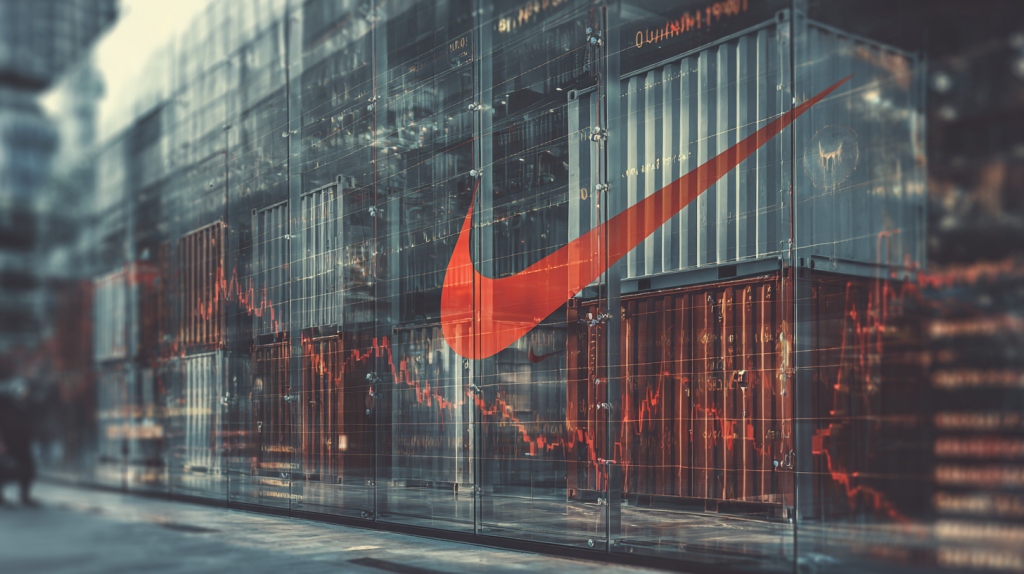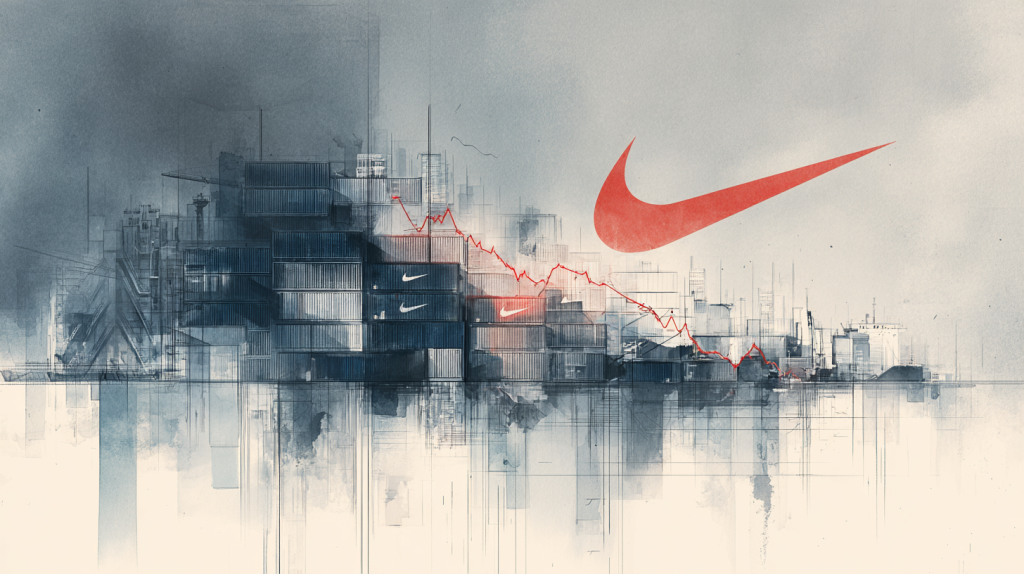
Table of Contents
Nike earnings tariff headwind is emerging as the defining drag on the world’s largest sneaker maker. The company’s latest quarterly report briefly pushed shares up by more than 4% in early trading, as earnings and sales beat Wall Street expectations. But beneath the headline numbers, Nike warned investors about a looming $1.5 billion tariff burden this fiscal year—a stark reminder that trade policy can upend even the most globally dominant brands.
Unlike Apple, which has subtly shifted its supply chain to soften U.S.-China tensions, Nike remains deeply tied to low-cost manufacturing across Asia. That dependency now exposes it to higher costs, slower shipping, and volatile politics. For investors, the relief rally faded once the deeper story settled: tariffs are an old enemy returning with new force.
Tariff Headwinds Drag on Nike Earnings Outlook
The phrase “Nike earnings tariff headwind” may sound like corporate jargon. But for shareholders, it translates into shrinking margins. Every percentage point hit on gross margin echoes across Nike’s $50 billion annual revenue base.
The warning is blunt: $1.5 billion in additional costs this year. Even for Nike, that drag is historic. By comparison, the company’s entire North American growth last year was worth $1.2 billion—which means the tariff bill alone will effectively cancel it out.
This isn’t the first time tariffs rattled Beaverton. Back in 2018, when the Trump administration escalated tariffs against China, Nike openly lobbied Washington to spare its supply chain. The effort worked temporarily. But 2025 may be different, as tariffs now come amid already slowing consumer demand and stiff competition from Adidas, Puma, and an aggressive new wave of Chinese brands like Anta and Li-Ning.
Global Growth Stalled by Soft China Demand
Nike’s China sales, once its fastest-growing region, slipped again. Beijing’s uneven consumer recovery means middle-class buyers are cutting discretionary spending. The sneaker giant structured much of its “China for China” strategy assuming endless growth—only to find that nationalism and tariffs complicate its appeal.
The irony is sharp. Nike executives spent years touting China as the brand’s “second home market.” But tariffs issued by Washington raise costs on imports, while Beijing’s consumer sentiment tilts toward domestic champions. For a brand whose trademark swoosh is as recognizable in Shanghai as in Seattle, the headwinds now extend in both directions.
Investors Brace for Impact from Nike Earnings Tariff Headwind
Wall Street analysts don’t miss the theme. “The Nike earnings tariff headwind is now the central drag on forward momentum,” wrote one Barclays analyst. The report suggested that margins could narrow by up to 120 basis points this fiscal year. Bloomberg confirmed Nike’s $1.5 billion tariff warning, underscoring just how central the policy shift is to its near-term outlook.
For readers tracking how global consumer companies respond differently, Amazon’s Alexa+ Echo upgrade illustrates how innovation-driven announcements can move markets in sharp contrast to Nike’s tariff drag.
Lessons From Past Trade Clashes

Nike is no stranger to political-economic storms. The company thrived in the 1980s and 1990s despite constant criticism over sweatshops. It survived the 2008 financial crash by doubling down on China. It pivoted to digital when retailers like Foot Locker faltered.
But tariffs are different. They aren’t cyclical; they are policy. That makes the Nike earnings tariff headwind less about consumer taste or trend, and more about trade law and geopolitics.
In past fights, companies could market or innovate their way out. Tariffs, however, simply raise costs. The question becomes whether Nike absorbs the hit, passes it along to consumers through higher prices, or cuts back on expenses elsewhere.
Competitors Smell Opportunity
Adidas, reeling from its own scandal-laden partnership with Kanye West, has leaned on classic models and European supply chains. Puma has positioned itself as a value alternative. And China’s Anta recently overtook Adidas in domestic market share.
All three competitors now benefit indirectly from Nike’s tariff struggles. If American tariffs disproportionately hit Nike’s imports, competitors with more localized supply chains may price more competitively at home.
But Nike has one ace: brand power. Its Swoosh and “Just Do It” remain cultural shorthand for performance and aspiration. That equity gives it pricing power—up to a point. Because if tariffs keep raising costs, even cultural icons fracture under economic strain.
Democratic Implications of Supply Chains
Step back from the stock ticker, and the Nike earnings tariff headwind story becomes part of something bigger: democracy’s uneasy relationship with globalization. For decades, U.S. trade policy allowed companies like Nike to offshore production for efficiency. Now, nationalist tariff policies push the opposite direction, with political leaders from both major parties betting that voters prefer domestic jobs over cheaper sneakers.
It’s a debate that reshapes more than margins. If tariffs are a permanent fixture of trade politics, companies will be forced into rethinking global integration. That comes with consequences—not just for investors, but also for workers across Southeast Asia whose livelihoods depend on multinational contracts.
Conclusion: A Test of Strategy and Patience
Nike’s ability to navigate the earnings tariff headwind will define its next chapter. Can the brand rewire its supply chain fast enough to mitigate costs? Will consumers tolerate higher sneaker prices when inflation already stretches wallets? Can investors wait for a turnaround?
The verdict is still out. But what’s clear is that Nike’s future performance will not just rest on sneaker design or influencer marketing. Instead, it will hinge on trade policy, tariffs, and the hard math of global supply chains.
For now, the swoosh may still fly—but heavier than before.